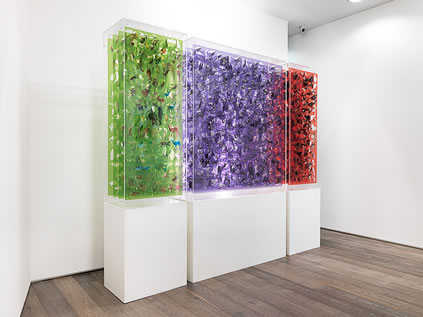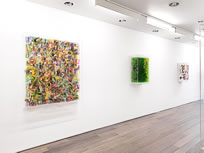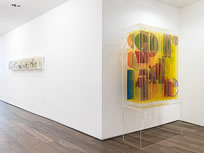Main Gallery
Jack Milroy
A Garden of Earthly Delights
17 March – 28 April, 2011
Art First is pleased to announce the first exhibition by Jack Milroy in the gallery’s newly relocated premises in Fitzrovia, close to Oxford Circus.
Opening in early Spring, ‘A Garden of Earthly Delights’ deliberately evokes the season’s energy and its bursts of organic growth, as well as Hieronymus Bosch’s 1505 masterpiece in the Prado Museum. Bosch’s triptych’s religious / moralizing content (the left panel represents Paradise, with Hell on the right and a marvellous central panel representing a garden of life’s ‘delights’ intertwined with mankind’s worldly pleasures) remains enigmatic to this day and continues to exert an abiding influence over artists now.
Milroy’s reading of earthly delights is contemporary and very much within the thematic developments in his own work. He shares with Bosch a sense of the fleeting beauty of flowers, the fragility of life and the ephemeral character of happiness, often hinting at the darker, more complex side of man’s behaviour.
The vocabulary of images in Milroy’s work Garden of Earthly Delights reveals itself only on close inspection. The printed and cut film construction presents three chromatic divisions with black and white printed imagery skillfully extracted from the surface with a scalpel, then twisted or tilted sideways into the space between parallel layers of film. The entire structure is suspended in a transparent Perspex box, which offers fascinating side views as well as the full frontal impact. The work’s intricacy is breathtakingly inventive as elephants, giraffes, gorillas and all manner of other flora & fauna emigrate from the green zone of Paradise to a more purple space of extremes. Rolls of bank notes, fast cars, brand names, diagrams from a year’s worth of daily sexual positions, signs of gluttony and excess and now and then a direct borrowing from Bosch himself lead the viewer towards the final zone of hellish red to the right, full of tumbling figures and accelerated chaos.
There is an overriding impression of energy throughout the work. In Territories animals of every kind move about in their particular colour zone, or ‘territory’, while the supple snakes in Knot a Snake emulate the discipline of specifically tied knots, and Flower Bed’s sumptuous foreground patterns of leaves and plants mask a dark, hovering eagle searching for prey.
Finally, there is his interest in the art of fellow Twentieth Century practitioners. In Le Rouge et le Noir, Milroy has taken the dance of paint from a Pollock, and made it 3-dimensional. He has used the pop out shapes from a children’s book on Calder, mimicking the order of the pages to create his own Calder, a weightless suspension of forms within a box.
Neither sculpture nor collage, Milroy’s resolutely independent and original work may best be described in Andrew Lambirth’s words as, that of a ‘planar collagist’. In his catalogue essay for the exhibition Cut (Art First, 2007), Lambirth puts it concisely:
It is work which uses recognizable figurative elements in different dispensations, guided by Milroy’s dependably casual wit and light poetic touch, into a new order of formal beauty
This exhibition is accompanied by a fully illustrated catalogue with a new essay by the writer & artist Simon Morley








